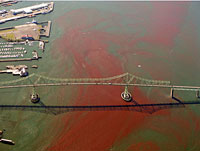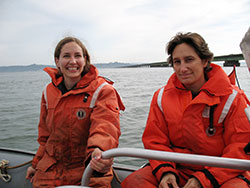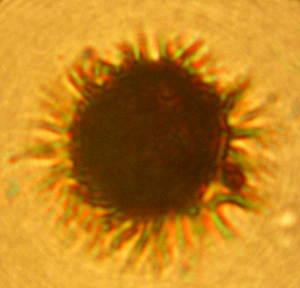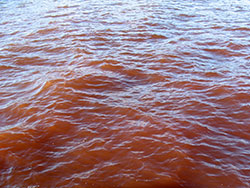You are here
CMOP Scientists Study Plankton Bloom in the Columbia River
11/18/08 Portland, Ore.
 Plankton bloom flows under Astoria bridge. Photo courtesy of Alex Derr
Plankton bloom flows under Astoria bridge. Photo courtesy of Alex Derr
Enlarge A small, inflatable boat bobs up and down in the estuary surrounded by a massive patch of red water. Aboard, two scientists, wearing bright colored survival suits, lower containers into the water. They are investigating the non-toxic plankton bloom that has formed in the Columbia River estuary.
Lydie Herfort, Ph.D. and Tawnya Peterson, Ph.D., scientists from the Center for Coastal Margin Observation & Prediction (CMOP), are studying a plankton bloom dominated by one type of organism called Myrionecta rubra. The organism is a eukaryotic protist, a single celled organism that swims up and down the water column. Under certain environmental conditions, the cells grow exponentially to millions of cells per liter of water within a few days. The cell is red in color and the shear numbers of them reflect the sun’s light and enhance their red color in the water.
Some plankton blooms have been referred to as red tides. The term “red tide” is a generic term for any type of large phytoplankton blooms in coastal waters, but they are not necessarily red, nor do they usually have anything to do with the tides. Some blooms can produce toxins that have a deleterious effect in the water where they overwhelm the rest of the organisms. In the case of the bloom in the Columbia River, the organisms do not produce toxins.
 Peterson with fellow researcher Katie Rathmell This year’s bloom occurred near the end of August, which is later in the season than usual. The reason for this is unclear. Scientists speculate the effect of nutrients from the ocean water coming into the estuary, combined with high light and water stability, might have played a role in the timing of the blooms growth.
Peterson with fellow researcher Katie Rathmell This year’s bloom occurred near the end of August, which is later in the season than usual. The reason for this is unclear. Scientists speculate the effect of nutrients from the ocean water coming into the estuary, combined with high light and water stability, might have played a role in the timing of the blooms growth.
Herfort and Peterson traveled to Astoria to collect samples of the plankton bloom. They gathered samples in both the dense red water and in clear patches of water. These samples will help them compare the conditions in the water and the influences the organism may be having in their environment.
 Close up Image of Myrionecta rubra taken from microscope “Myrionecta rubra is a distinctive looking cell with a band of cilia around its waistline” Peterson said. "They are genetically complicated because they are not just one organism but have “stolen” chloroplasts and nucleus from other phytoplankton (cryptophytes only) and use it within their own cells to photosynthesize."
Close up Image of Myrionecta rubra taken from microscope “Myrionecta rubra is a distinctive looking cell with a band of cilia around its waistline” Peterson said. "They are genetically complicated because they are not just one organism but have “stolen” chloroplasts and nucleus from other phytoplankton (cryptophytes only) and use it within their own cells to photosynthesize."
One theory for their success in the estuary is that they are able to remain there despite tidal flushing; they appear to have some ability to ride the tide. “They vertically migrate, rising to the surface when the tide is coming in and then when the tides go out, they go down and so they don’t have to leave the estuary,” Peterson said.
Myrionecta rubra has been a subject of study for five years by NOAA researcher Curtis Roegner, who has watched it come and go almost every year. “The mystery is it’s so tiny, yet its swimming behavior keeps it in the estuary,” Roegner said. Together with the efforts of Roegner, member of the CMOP team - Herfort, Peterson, and microbiologist Peter Zuber, Ph.D. - are interested in studying the biology of the bloom.
CMOP scientists have already analyzed several samples collected during last year’s bloom. Herfort and Zuber primarily use molecular biology techniques to look at the genetic fingerprints of these organisms as well as that of eukaryotes and prokaryotes associated with the bloom. This molecular work is carried out in collaboration with Lee Ann McCue Ph.D., a scientist from Pacific Northwest National Laboratory, who performs genetic sequence analysis.
“Our data will improve our understanding of the ecological impact of Myrionecta rubra bloom on the Columbia River estuary,” Herfort said.
 Eventually whatever caused the Myrionecta rubra to grow rapidly will change and they will no longer have a source of nutrients. “When they die, they decompose and bacteria can feed on it," Peterson said. "The growth of bacteria then draws down the oxygen while they are respiring. So while the bloom itself is not toxic, the byproduct may have a harmful effect to other species.” Due to a great deal of water flow and flushing in the Columbia River, this currently is not a danger of happening.
Eventually whatever caused the Myrionecta rubra to grow rapidly will change and they will no longer have a source of nutrients. “When they die, they decompose and bacteria can feed on it," Peterson said. "The growth of bacteria then draws down the oxygen while they are respiring. So while the bloom itself is not toxic, the byproduct may have a harmful effect to other species.” Due to a great deal of water flow and flushing in the Columbia River, this currently is not a danger of happening.
There are several unanswered questions that CMOP researchers are exploring. Is the Myrionecta rubra an important “environment sentinel” for the estuary? What controls timing and behavior of the bloom? The CMOP research team wants to start answering these and other questions by using a combination of physiological studies, molecular work, and observations and simulations from their end-to-end coastal margin observatory titled SATURN. They hope this will provide clues about the factors that lead to plankton blooms, and ultimately improve the ability to predict these events.
Written by Jeff Schilling






